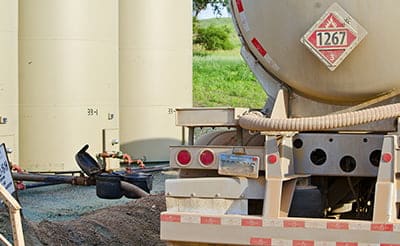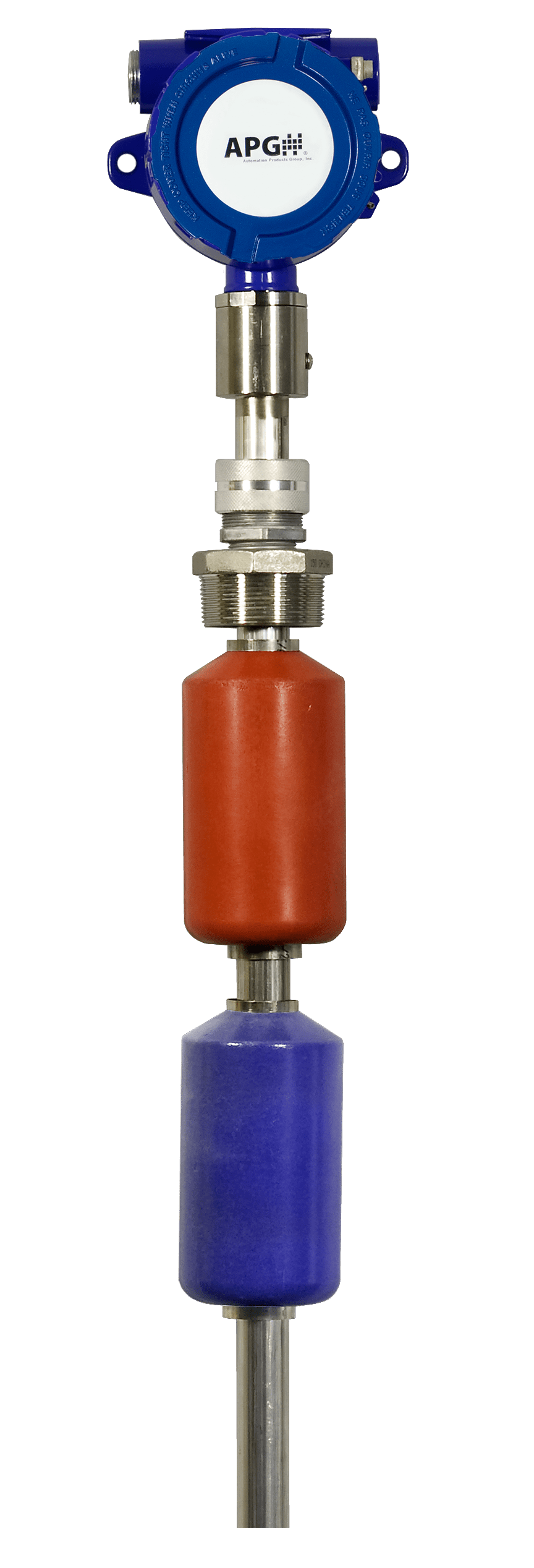 APG recently introduced the new API 18.2 MPX Custody Transfer Approved Magnetostrictive Float Level Sensors. We also provided you with a quick synopsis of API 18.2 and its importance for increasing safety and accuracy in crude oil custody transfers from lease storage tanks. In this post, we will tie the two together, showing you how our API 18.2 MPX sensors meet the requirements of API 18.2.
APG recently introduced the new API 18.2 MPX Custody Transfer Approved Magnetostrictive Float Level Sensors. We also provided you with a quick synopsis of API 18.2 and its importance for increasing safety and accuracy in crude oil custody transfers from lease storage tanks. In this post, we will tie the two together, showing you how our API 18.2 MPX sensors meet the requirements of API 18.2.
API 18.2 provides specifications for equipment being used for level and temperature measurement of crude oil being transferred from a lease tank to a tanker truck (Custody Transfer). These equipment specifications replace the manual measurement procedures from API 18.1, creating safer working conditions for the workers taking the measurements, and increasing the accuracy of the measurements being taken.
API 18.2 delineates three physical spaces where custody transfer measurements can be taken: the Tank Zone, the Truck Zone, and the intermediary Transfer Zone. Equipment in the Transfer Zone is necessarily temporary: you can’t permanently install measurement equipment on the temporary piping between the lease tank and the tanker truck. Equipment on the truck or tank can be either temporary or permanent. Electronic level measurement systems permanently installed on a tank are known as Automated Tank Gauging systems. An API 18.2 MPX from APG is a permanently installed level and temperature sensor, and thus part of an ATG, which are governed by API 18.2 Section 11.4, “Automated Tank Gauging Systems.”
Section 11.4 of API 18.2 doesn’t specify the technologies or methodologies to be used by ATGs in obtaining level and temperature measurements, just the requirements for those measurements. Let’s look at the requirements laid out in those subsections, and how the API 18.2 MPX meets those requirements.
An ATG must have a “sufficient dynamic response time to reliably track liquids” during periods of maximum filling or emptying. However, it must also be able to identify and ignore surface disturbances. The API 18.2 MPX has a variable sample rate of 50 – 1000 milliseconds, along with averaging and out of range samples functions that can be tuned to respond quickly to large jumps, but smooth out smaller ripples.
Tank temperature measurements should be made simultaneous to level measurements. The digital temperature sensors in the API 18.2 MPX are continuously monitored by the control software, and the averaged output of the submerged sensors is updated multiple times per second.
 Rather than make its own temperature accuracy statement, API 18.2 refers to MPMS Chapter 7, “Temperature Determination,” for the specifics of how to measure the temperature of oil in a lease tank. Table 5, in Section 6, Static Temperature Determination, states that a liquid depth of more than 3.0 m (or 10 feet) requires at least three temperature sensors be used, and that a difference of more than 1°C (2°F) between sensors necessitates averaging the readings of the temperature sensors, with result rounded to nearest 0.05°C (0.1°F). Section 8.1 requires permanently installed Automatic Tank Thermometers (which the digital temperature sensors in an API 18.2 MPX are) to be calibrated to ±0.25°C (±0.5°F). The digital temperature sensors in the stems on API 18.2 MPXs have a stated accuracy of ±0.25°C (±0.5°F) over an operating range of -40° to 85°C. Between 20° and 70°C, their accuracy increases to ±0.13°C (±0.25°F). And, as noted above, the readings from submerged digital temperature sensors are continuously averaged, and the result is available to be read simultaneous to the level output of the probe.
Rather than make its own temperature accuracy statement, API 18.2 refers to MPMS Chapter 7, “Temperature Determination,” for the specifics of how to measure the temperature of oil in a lease tank. Table 5, in Section 6, Static Temperature Determination, states that a liquid depth of more than 3.0 m (or 10 feet) requires at least three temperature sensors be used, and that a difference of more than 1°C (2°F) between sensors necessitates averaging the readings of the temperature sensors, with result rounded to nearest 0.05°C (0.1°F). Section 8.1 requires permanently installed Automatic Tank Thermometers (which the digital temperature sensors in an API 18.2 MPX are) to be calibrated to ±0.25°C (±0.5°F). The digital temperature sensors in the stems on API 18.2 MPXs have a stated accuracy of ±0.25°C (±0.5°F) over an operating range of -40° to 85°C. Between 20° and 70°C, their accuracy increases to ±0.13°C (±0.25°F). And, as noted above, the readings from submerged digital temperature sensors are continuously averaged, and the result is available to be read simultaneous to the level output of the probe.
Measurements from an ATG should be recorded when they are made, i.e., there shouldn’t be a long delay between when a measurement is made and when it is recorded for the Custody Transfer. The calculated output registers of the API 18.2 MPX are updated according to the Samples and Averaging settings mentioned above, so the probe output is always a current reading (instead of a peak reading or a delayed reading). How the ATG handles that output is up to the system designer or integrator.
The primary accuracy requirement for ATG used in Custody Transfer comes from API MPMS Chapter 3.1B, “Standard Practice for Level Measurement of Liquid Hydrocarbons in Stationary Tanks by Automated Tank Gauging”, Section 4.3.4, Table 1: Factory calibration requirement for ATG in used in Custody Transfer is ±1 mm (1/16”). Table 1 provides for added tolerance after installation, so the factory calibration requirement is the most stringent. Most other chapters, including 18.2, refer back to chapter 3.1B for ATG accuracy requirements, rather than stating their own requirements. APG’s API 18.2 MPX probes have a stated accuracy of ±0.04” or ±1 mm over the length of the probe.
“The same procedures should be used to measure a tank level before the product transfer (opening gauge) and after the product transfer (closing gauge).” That’s pretty straight forward. And it’s no problem for the API 18.2 MPX. The top and bottom dead bands of the API 18.2 MPX allow for measurement along almost the entire length of the stem, providing the same accuracy to full tanks and empty tanks alike. Additionally, a dual-float API 18.2 MPX would be able to clearly show the change in oil level while the oil-water interface level (ideally) stays steady, indicating that little-to-no water was pumped out with the oil.
 The product shouldn’t destroy the ATG; at the same time, the ATG can’t contaminate the product. This is Level Measurement 101 stuff. Any sensor should be materially compatible with whatever medium it is measuring. Because of the range of chemical makeups possible with crude oil storage, there are two stem materials available for the API 18.2 MPX : 316L stainless steel, and titanium 2. The MPX-R uses 1”-Ø, 316L stainless steel tubing, which works well in most sweet crude applications. For sour crude applications, the 1”-Ø titanium 2 stem of the MPX-T is able to handle the increased H2S (hydrogen sulfide) concentrations.
The product shouldn’t destroy the ATG; at the same time, the ATG can’t contaminate the product. This is Level Measurement 101 stuff. Any sensor should be materially compatible with whatever medium it is measuring. Because of the range of chemical makeups possible with crude oil storage, there are two stem materials available for the API 18.2 MPX : 316L stainless steel, and titanium 2. The MPX-R uses 1”-Ø, 316L stainless steel tubing, which works well in most sweet crude applications. For sour crude applications, the 1”-Ø titanium 2 stem of the MPX-T is able to handle the increased H2S (hydrogen sulfide) concentrations.
ATGs need to be tamper-proof, both because of the value of the product in the lease tanks, and because they are often in isolated areas, away from security cameras and personnel. The API 18.2 MPX is installed in a Class I Div 1 area of the lease tank, and its explosion proof rating is dependent on conduit or extremely heavy-duty cable being used to connect it to the rest of the ATG system. The API 18.2 MPX also has no physical user interface; its settings can only be changed via Modbus communications. So in order to tamper with the API 18.2 MPX, one would either have to gain access to the Modbus network through an unsecured device on the network (which would violate this subsection), or physically cut into the explosion proof cable/conduit, and insert a new Modbus network server.
Where subsections 11.4.4b and 11.4.4f independently considered the timeliness of the measurements taken by the ATG and the physical security of the ATG, this subsection deals with the security and timeliness of the transmission of the measurement data by the ATG. The communication methods of the ATG must guard against: changing the value of the measurements (data corruption), degrading the accuracy of the measurements (rounding errors), allowing unintended or unwanted parties to view or change the measurements (eavesdropping), allowing too much time to elapse between the measurement and its display (time delay), and electromagnetic interference. The Modbus communication used by the API 18.2 MPX takes care of most of these potential problems. The structure of Modbus communication eliminates data corruption and rounding errors, and the steady baud rate of a Modbus network eliminates the possibility of time delay. In theory, a Modbus network might invite the addition of more client or sniffer devices to the network, but as noted in Subsection 11.4.4f, the API 18.2 MPX requires explosion proof conduit or cable for installation, and that makes physical alterations to the Modbus network difficult at best. Using twisted-pair wiring for the Modbus network eliminates nearly all electromagnetic interference.
APG’s API 18.2 MPX easily meets the requirements for an Automated Tank Gauging system, as stipulated by API 18.2 Section 11.4, along with the accuracy calibration standards for both level and temperature reporting. Using an API 18.2 MPX will provide the required level and temperature measurements before and after transferring oil from a lease tank to all interested parties in a safe and secure manner. As with API 18.2 in general, everybody wins with an API 18.2 MPX from APG.
Do you have questions about the APG's API 18.2 MPX-R or MPX-T, or any of APG’s other Explosion-proof or Intrinsically Safe Magnetostrictive Level Probes? Send our Measurement Experts an email, give them a call, or even chat with them live, right here on our website. They would love to help you find the best probe level measurement solution for your unique needs.
top photo credit: Tim Evanson via flickr.com cc by s-a 2.0 edited, cropped